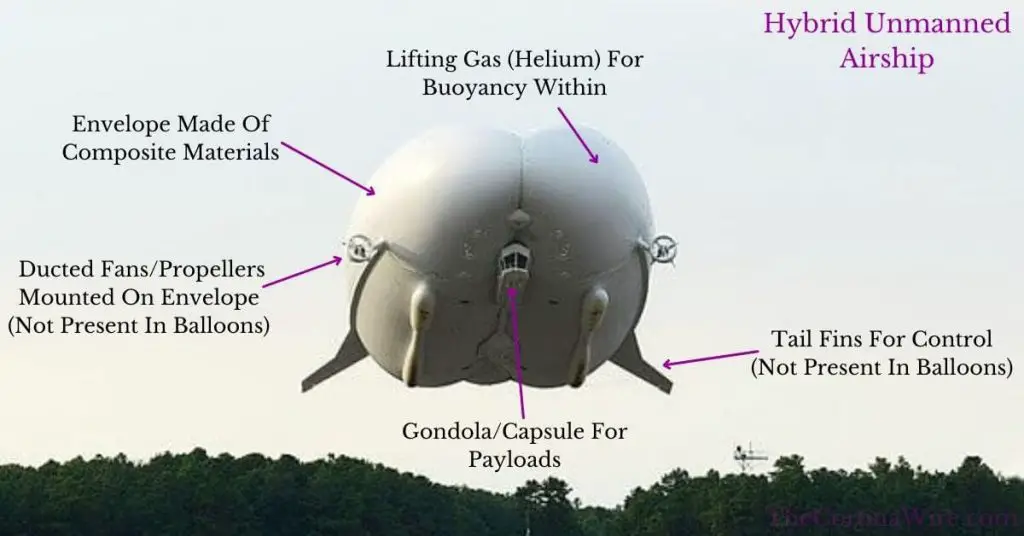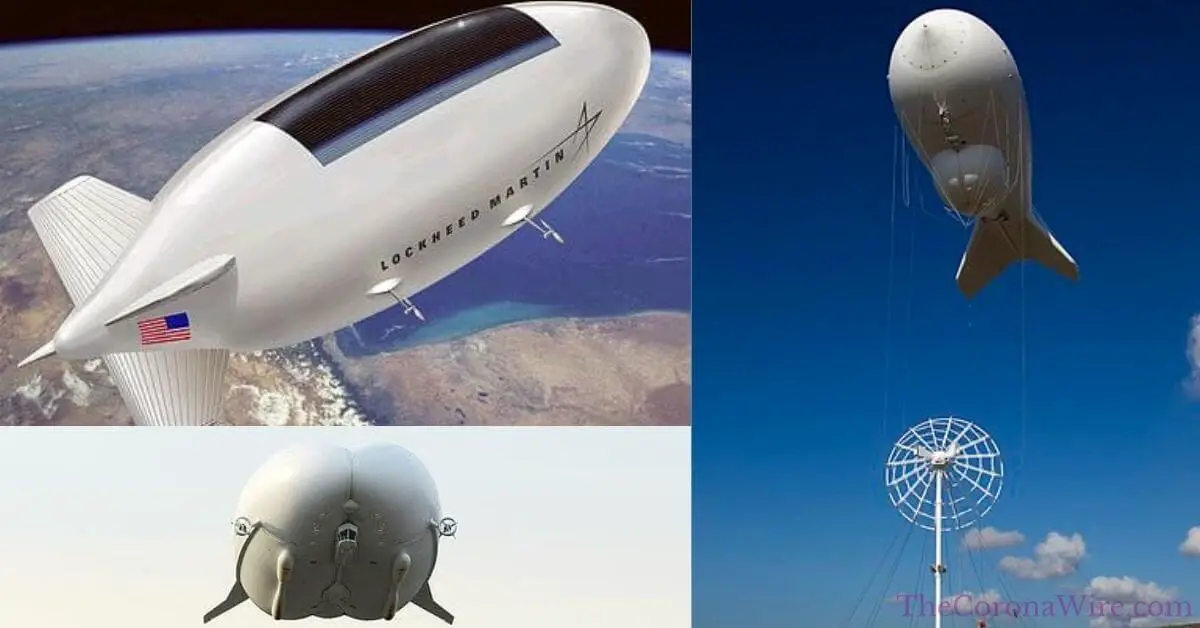Unmanned airships, also known as unmanned dirigibles or airship drones/unmanned aerial vehicles (UAVs) are rising in popularity once again.
These types of aircraft were once some of the most popular drones used but became lost in the rapid development of technology that brought us improved versions and new types of UAVs such as fixed-wing UAVs, rotary-wing UAVs, and even hybrid fixed-wing/VTOL UAVs.
What are unmanned airships?
Unmanned airships are types of powered aerostat drones/unmanned aerial vehicles (UAVs) that generate lift using buoyancy in the form of lifting gas while being propelled and steered using a propulsion system and control surfaces.
These types of aircraft are considered lighter-than-air UAVs.
Take note that unmanned hybrid airships will not be included in this article.
- How Do Unmanned Airships Work?
- What Are The Types Of Unmanned Airships?
- What Are Unmanned Airships Used For?
- What Parts/Components Make Up Unmanned Airships?
- What Are The Advantages & Disadvantages Of Unmanned Airships?
- Unmanned Airship Power Sources/Propulsion Devices
- What Are Some Examples Of Unmanned Airships?
- Conclusion
How Do Unmanned Airships Work?
Unmanned airships use lifting gas (typically helium) as it’s less dense than the air outside that is contained within an envelope to obtain buoyancy and float in the air.
Buoyancy is a force typically found in fluids where an object of a certain weight will either rise, float, or sink depending on whether it is less dense (rises), equal in density (floats), or denser (sinks) than the fluid it’s in.
The pressure exerted on the object will typically increase the deeper it sinks.

Unmanned airships will typically not inflate their envelopes (or gasbags in the case of rigid airships) fully as the higher they go, the lower the pressure outside gets which will cause the lighter-than-air gas within to expand.
Once the pressure within the envelope is equal to the pressure in the surrounding air, they will have reached the pressure height. Flying higher than this will increase the risk that the envelope/gasbags rupture as the materials used to contain lifting gas are only so strong.
Helium is used as lifting gas as it’s non-flammable, effective and safe. In the past, they used hydrogen which is far more dangerous as it’s flammable.
The shape of their main envelopes can be maintained using internal pressure (non-rigid/blimps), can be maintained using both internal pressure and a supporting structure (semi-rigid), or can be maintained using an outer structural framework (rigid).
Unmanned airships are powered using various power sources such as batteries, fuel cells, solar energy, and are also directly powered using powered tethers and propulsion devices such as propellers.
Check out our full post on drone propellers including the different types, how they work, their different sizes and pitch, their materials, how to choose them and much more.
Related Post: Drone Propellers Explained: Detailed Beginner’s Guide To Drone Anatomy
Power is either supplied via a ground/mobile control station through a powered tether or is found on-board the aircraft itself.
They can be steered using control devices found on the tail assembly of the aircraft which typically includes tail fins that can act as rudders.
Tethered unmanned airships have a grounded anchor point that they attach to in order to stay at a fixed location in the air.
Unmanned airships often have ground/mobile control stations where the operators can receive and measure data gathered from the aerostat. This data can be sent wirelessly using radio waves or through a powered tether.
The size of the main envelope will impact the maximum flight time, range, and altitude the airship can attain.
No aerostat can fly forever as the lifting gas stored within the main envelope will continuously leak. They need to be refuelled with helium for extended use.
For landing and docking, unmanned airships typically have large structures that connect to the nose of the aircraft with additional cables and machines supplying a specific amount of helium to make them neutrally buoyant so that they don’t float away.
Check out our full post on unmanned aerostats where we dive into how they work, their types, applications, parts/components, advantages/disadvantages, propulsion systems and examples:
Related Post: What Are Unmanned Aerostats? Floating Drones/UAVs Explained
What Are The Types Of Unmanned Airships?
The types of unmanned airships can be separated according to the structure of their envelopes.
Here are the 3 types of unmanned airships:
- Non-rigid unmanned airships/unmanned blimps
- Semi-rigid unmanned airships
- Rigid unmanned airships
Non-rigid unmanned airships, also called unmanned blimps, are types of unmanned airships that use internal pressure from lifting gas and the envelope itself to keep the shape of their envelopes filled.
Semi-rigid unmanned airships are types of unmanned airships that rely on both internal pressure from lifting gas and an internal structural framework to maintain the shape of the envelope.
Rigid unmanned airships are types of unmanned airships that rely solely on an internal structural framework to maintain the shape of the envelope. They typically have several gasbags, balloons, or cells filled with lifting gas within the envelope for buoyancy.
What Are Unmanned Airships Used For?
Here are 5 applications for unmanned airships:
- Extending the reach/capacity of communications systems
- Aerial advertising
- Measuring weather patterns
- High-altitude ISR
- Long distance cargo delivery
Check out our full post on aerostat drone applications where we explain what each use case entails and how unmanned aerostats are used in them:
Related Post: 6 Awesome Unmanned Aerostat Drone Applications Explained
What Parts/Components Make Up Unmanned Airships?
Unmanned airships are made of an envelope, gondola/capsule, tail assembly/empennage, propulsion system, communications system, payload, and sometimes a tether.
The envelope is a sack made of fabric that contains the lifting gas enabling an unmanned airship to fly.
These can be either pressurized (non+semi-rigid) or unpressured (just rigid) either containing the lifting gas itself (non-rigid), the lifting gas with an internal structure (semi-rigid), or gasbags, balloons, or cells containing lifting gas with an additional structural framework (rigid).
These types of unmanned aerostats rival unmanned balloon aerostats.
Check out our full post on unmanned balloon aerostats where we dive into how they work, their types, applications, parts/components, advantages/disadvantages and examples:
Related Post: What Are Unmanned Balloons? Aerostat Drones/UAVs Explained
A gondola/capsule is a compartment typically suspended beneath the main envelope of an unmanned airship that holds the payload.
The tail assembly/empennage is typically made of tail fins which can act as rudders to control the drone’s yaw and tailplanes/horizontal stabilisers which can act as elevators to control the drone’s pitch.
The propulsion system includes power sources such as batteries, fuel cells and solar cells. Propulsion devices within the system are typically propellers used to generate thrust.
These propulsion devices can be placed in various positions on the UAV including the tail assembly, the gondola/capsule, and attached directly to the envelope.
The communications system is the system enabling an unmanned airship to send and receive data to and from the operator/s. This data can be the information gathered by onboard payloads or the inputs made by the operator/s to steer the drone.
Payloads include any additional weight the unmanned airship can carry that is not essential for it to function other than its base weight. This includes sensors and freight.
Tethered unmanned aerostats are going to need both tethers of certain lengths and an anchor point. These tethers can either be powered or unpowered.
Check out our post where we dive into what drone tethers are, the different types, uses, advantages/disadvantages, materials they’re made of, costs, examples and more:
Related Post: Drone Tethers Explained: What They Are & How They Work
Powered tethers are commonly referred to as ‘live’ tether systems whereas unpowered tethers are commonly referred to as ‘dead’ tether systems.
The anchor point can also be a ground/mobile control station enabling operators on the ground to monitor and measure data taken from the payloads found on the UAV.
Unmanned airships can carry various payloads including but not limited to electro-optical/infrared (EO/IR) sensors, freight and radiosondes (telemetry instruments that measure pressure, wind conditions, altitude, temperature etc) to state a few.
Unmanned airships are typically required to have lights and radar reflectors and are required to follow certain rules that vary by country in order to operate legally and safely to prevent mid-air collisions with other aircraft.
What Are The Advantages & Disadvantages Of Unmanned Airships?
We’ve split up the advantages and disadvantages into their own separate sections.
Unmanned airship advantages
Here are 5 advantages of unmanned airships:
- They are typically very stable
- They are mobile increasing the applications it can be used for
- They typically have very high payload capacities
- They can fly for very long periods of time
- They can be made very durable capable of widthstanding rough weather conditions
Unmanned airship disadvantages
Here are 5 disadvantages of unmanned airships:
- They require additional power sources to power their propulsion devices
- They are very slow
- The helium used for lifting gas is expensive
- Tethered airships have a limited operating range
- They have to be grounded/anchored in order to provide a resupply of helium in order to extend operating time
Unmanned Airship Power Sources/Propulsion Devices
Here are 5 power sources/propulsion devices used in unmanned airships:
- Batteries
- Motors
- Propellers
- Solar Cells
- Powered tethers
Check out our full post where we dive into several power sources and propulsion devices currently used in drones. For each power source, we expand on how they work, the different types, the advantages, disadvantages, and real-world examples of drones that use it.
Related Post: How Are Drones Powered? 6 Drone Energy Sources Explained
What Are Some Examples Of Unmanned Airships?
Here are 6 examples of unmanned airships:
| Name | Manufacturer | Type |
| Persistent Threat Detection System (PTDS) 74K | Lockheed Martin | Non-Rigid/Blimps |
| Tethered Aerostat Radar System (TARS) 420k | Lockheed Martin | Non-Rigid/Blimps |
| DATT SA-70 | UAV Corp+Skyborne Technology | Semi-Rigid |
| GA22 | BAE Systems | Non-Rigid/Blimp |
| High Altitude Airship (HAA) | Lockheed Martin | Non-Rigid/Blimps |
| Corsair | Euro Airship | Rigid |
If you’d like to discover who the best drone companies are in the world for the consumer, commercial and military drone markets and some fun facts about them, we have a full post on this topic below:
Related Post: Top Drone Companies/Manufacturers In The World [History, What They Offer, Popular Drones And More]
Conclusion
These types of unmanned aerostats are proven to be very useful tools that can be used in a variety of applications. They may soon be as popular as other types of aerial drones.
If you’d like to learn more about this technology, we highly recommend you check out our full post on what unmanned aerostats are and how they work.
